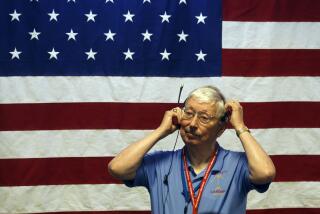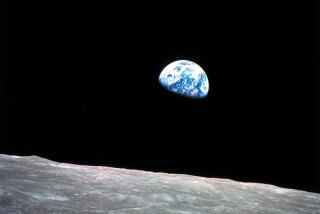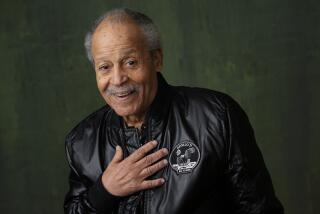Oldest U.S. Astronaut Still Agog Over Space
SPACE CENTER, Houston — His commander aimed to go skiing after their space shot. But John Young didn’t want R&R.; All he wanted was to go back up.
As soon as possible. As often as possible.
“I’ll be ready to go again as soon as I hit the water with Gemini 3,” the 34-year-old rookie astronaut promised before blasting off with Gus Grissom on America’s first two-man space flight.
That was spring 1965.
In spring 2000, after a record six rocket launches--seven, if you count his liftoff from the moon--Young still has no urge to unwind. At 69, he is an active astronaut--the corps’ oldest by more than a decade. He is also the country’s most experienced space commander.
His Gemini and Apollo peers have long since left NASA for cushy corporate or consulting jobs, or retirement. So have many of his younger space shuttle colleagues.
But Young keeps toiling at the Johnson Space Center in Houston, now as associate director of technical and safety issues. He maintains his status as senior astronaut, even though he hasn’t been in orbit for more than 16 years and almost certainly will never go back up.
To command a third space shuttle mission would mean taking the job away from a pilot who could use the experience, with the international space station gearing up.
To go along as a passenger, a la John Glenn, holds little appeal. Not after flying in the front left seat; Young was, after all, the first space shuttle commander. Not after flying to the moon twice and roaming its surface; Young was the ninth of 12 moonwalkers.
Besides, he says with a smile, his wife wouldn’t let him.
So this slight, fit-looking grandfather climbs into the shuttle simulator every few weeks and tries to make the shuttle safer for others.
All he wants, he says in a soft drawl, is to “hang in there and keep reminding people about what they ought to be thinking about.”
“We need to know what our limitations are, and we need to expand our capabilities, and that’s my job.” Shuttle. Station. Back to the moon and on to Mars. Some 140 technical items.
Forget relaxing, let alone retiring.
“My relaxing is usually thinking of something else to work on,” Young admits.
Gene Cernan, who circled the moon with Young on Apollo 10, jokes about his persistence.
“In about 100 million years, they’ll dig up the city and find the Johnson Space Center and there will be John Young sitting at a desk or in a simulator,” he says.
In earnest, Cernan adds: “He feels he can make a difference and, God bless him, he has made a difference.”
It’s inspiring, says former shuttle astronaut Rick Hieb, to see “this icon” sticking around and shoveling coal. “You have to work your butt off because John always worked his butt off. No slacking.”
Young is NASA’s conscience as well as its role model. His memos can be blistering, his push for change relentless.
Right now, Young is pushing to bring the shuttle down at an airfield along the East Coast if one or more engines fail during the climb to orbit or some other calamity strikes. He says a landing minutes after liftoff is preferable to bailing out over the frigid North Atlantic.
It would be like the Titanic, Young says. “They wouldn’t make it.”
His plan has NASA managers shaking their heads. “They were shaking them like this,” Young says, nodding. “But they really meant like this,” he says, shaking his head no.
NASA has changed.
“In the old days,” Young says, “we really didn’t know what we were doing. We just went and did it. Now everybody has their little bureaucratic piles.”
Clearly, Young tells it like it is.
Take the National Aeronautics and Space Act of 1958, which makes progress in science and technology, and exploration, a matter of federal law.
“You kind of wonder why a lot of people aren’t in jail,” Young quipped while accepting this year’s Rotary National Award for Space Achievement.
That kind of talk could kill a career. Why not Young’s?
“Because he’s usually right,” says Floyd Bennett, an engineer who helped put Young on the moon. Like Young, he is still in the space business.
“He’s a little grumpy,” Bennett adds with a laugh. “He’s always been outspoken. He wants it done right.”
Young says he spoke out to Grissom before the Apollo 1 spacecraft inferno on the launch pad in 1967.
“Why don’t you say something about these wires? They’re terrible,” he told the Apollo 1 commander. “ ‘I can’t say anything about the wires or I’d get fired.’ That’s what he told me.”
Days later, Grissom and two other astronauts died in a fire caused by an electrical spark.
Young spoke out again after the 1986 Challenger disaster. As chief astronaut, he was critical of the way NASA had sacrificed safety for schedule.
“You don’t want to be politically correct,” he says. “You want to be right.”
Young was preparing for a seventh mission--to deliver the Hubble Space Telescope to orbit--when Challenger blew up. As NASA recovered, he was shifted to desk assignments.
Before Hubble’s launch in 1990, Young discovered that the telescope had never been completely tested, end to end. He warned managers something could go wrong. Something did: It wasn’t until the Hubble was in orbit that NASA discovered its mirror was flawed and its vision blurred.
“Man, if I’d been on that mission and found out way ahead of time,” Young says, pausing. “Yeah, I probably would have been in real trouble.”
Young insists he doesn’t like stirring things up. He just wants things to work. “If they’re OK, I don’t say nothing.”
Young learned to work hard early on. His father, a civil engineer and onetime Navy man, hopped job to job and state to state during the Depression. The family wound up in Orlando, Fla., 50 miles west of a scrub-covered spit of coast called Cape Canaveral.
As a youngster, Young built model planes and sketched planes and even rockets--a curiosity in the 1940s. In high school, he took his first plane ride, aboard a PT-19.
In 1952, Young earned a bachelor’s degree in aeronautical engineering from the Georgia Institute of Technology, then joined the Navy and put in for flight training. He instead found himself on a destroyer bound for Korea.
A year later, Young began flight training. As a test pilot, in 1961, he was flying Crusader and Phantom fighters when President Kennedy pledged to put a man on the moon by the end of the decade.
Young competed for an astronaut slot alongside Navy pals Pete Conrad and Jim Lovell. Meanwhile, he pushed the supersonic F-4 Phantom to world time-to-climb records at altitudes of 3,000 and 25,000 meters.
In 1962, Young, Conrad and Lovell joined the second group of astronauts, aptly named the Next Nine. Three years later he became the first of his group to fly in space, circling Earth three times aboard Gemini 3 with Mercury astronaut Grissom.
It was also the first catered space shot when Young smuggled a corned beef sandwich aboard for Grissom. The ensuing flap didn’t last long.
Young went back up in 1966 on Gemini 10, as commander, and farther up still, into lunar orbit, as command module pilot of Apollo 10 in 1969. He went all the way to the lunar surface as commander of Apollo 16 in 1972.
As a retired Navy captain, Young was at the controls when Columbia blasted off on the first space shuttle flight in 1981. Two years later, he became the first repeat shuttle skipper on Columbia’s sixth flight.
Photos, plaques, awards from those missions fill a room--”a me room”--of the home he shares in the Houston area with Susy, his wife of nearly 30 years. Two children from a first marriage live near Cape Canaveral, along with two granddaughters.
The “me” fades when Young gazes at the moon. “I just wonder why we don’t have people up there exploring right now,” he says.
Moon bases, Mars shots, asteroid encounters, maybe even multi-planetary excursions?
“Our ability to live and work on other places in the solar system will end up giving us the science and technology that we need to save the species,” Young says in earnest.
“I’m talking about human beings.”
Then he grins.
“I’d hate to miss all that fun.”
*
On the Net: NASA biography of Young: https://www.jsc.nasa.gov/Bios/htmlbios/young.html
‘My relaxing is usually thinking of something else to work on.’
More to Read
Sign up for Essential California
The most important California stories and recommendations in your inbox every morning.
You may occasionally receive promotional content from the Los Angeles Times.









